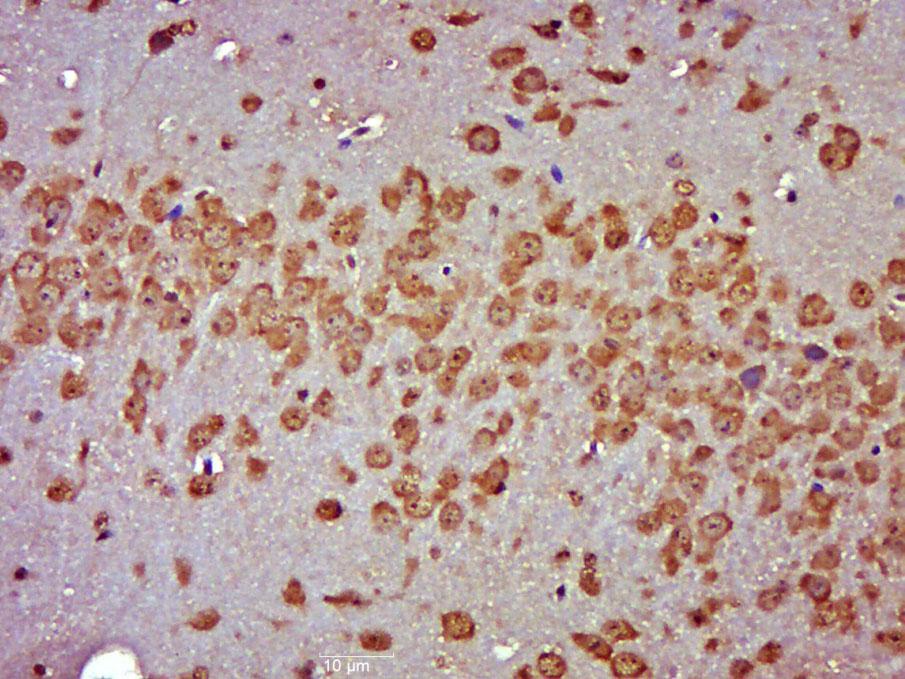
Rabbit Anti-RGS7 antibody
OTTHUMP00000037994; Regulator of G protein signalling 7; Regulator of G-protein signaling 7; Regulator of G-protein signaling RGS7; Regulator of G-protein signalling 7.
View History [Clear]
Details
Product Name RGS7 Chinese Name G protein signal转导调节因子7抗体 Alias OTTHUMP00000037994; Regulator of G protein signalling 7; Regulator of G-protein signaling 7; Regulator of G-protein signaling RGS7; Regulator of G-protein signalling 7. Research Area Cell biology Neurobiology Signal transduction G protein signal Immunogen Species Rabbit Clonality Polyclonal React Species Mouse, (predicted: Human, Rat, Chicken, Dog, Cow, Horse, Rabbit, Zebrafish, Sheep, ) Applications ELISA=1:5000-10000 IHC-P=1:100-500 IHC-F=1:100-500 ICC=1:100-500 IF=1:100-500 (Paraffin sections need antigen repair)
not yet tested in other applications.
optimal dilutions/concentrations should be determined by the end user.Theoretical molecular weight 58kDa Cellular localization The nucleus cytoplasmic Form Liquid Concentration 1mg/ml immunogen KLH conjugated synthetic peptide derived from human RGS7: 221-320/495 Lsotype IgG Purification affinity purified by Protein A Buffer Solution 0.01M TBS(pH7.4) with 1% BSA, 0.03% Proclin300 and 50% Glycerol. Storage Shipped at 4℃. Store at -20 °C for one year. Avoid repeated freeze/thaw cycles. Attention This product as supplied is intended for research use only, not for use in human, therapeutic or diagnostic applications. PubMed PubMed Product Detail RGS7 inhibits signal transduction by increasing the GTPase activity of G protein alpha subunits thereby driving them into their inactive GDP bound form. Activity on G(o) alpha is specifically enhanced by the RGS6/GNG5 dimer. RGS7 may play a role in synaptic vesicle exocytosis and may play an important role in the rapid regulation of neuronal excitability and the cellular responses to short lived stimulations.
Function:
Chaperone that plays a key role in various processes such as apoptosis, insertion of tail-anchored (TA) membrane proteins to the endoplasmic reticulum membrane and regulation of chromatin. Key component of the BAG6/BAT3 complex, a cytosolic multiprotein complex involved in the post-translational delivery of tail-anchored (TA) membrane proteins to the endoplasmic reticulum membrane. TA membrane proteins, also named type II transmembrane proteins, contain a single C-terminal transmembrane region. BAG6/BAT3 acts by facilitating TA membrane proteins capture by ASNA1/TRC40: it is recruited to ribosomes synthesizing membrane proteins, interacts with the transmembrane region of newly released TA proteins and transfers them to ASNA1/TRC40 for targeting to the endoplasmic reticulum membrane. Moreover, it regulates the stability and the degradation of proteins by the proteasome. For instance, it is required for selective ubiquitin-mediated degradation of defective nascent chain polypeptides by the proteasome. In this context, may play a role in immuno-proteasomes to generate antigenic peptides via targeted degradation, thereby playing a role in antigen presentation in immune response. It is also involved in ubiquitin-mediated proteasomal degradation of proteins of the secretory pathway that are mislocalized to the cytosol. Binds the mislocalized proteins, preventing their aggregation in the cytosol, and promotes their ubiquitination. Participates in endoplasmic reticulum stress-induced apoptosis via its interaction with AIFM1/AIF by regulating AIFM1/AIF stability and preventing its degradation. Also required during spermatogenesis for synaptonemal complex assembly via its interaction with HSPA2, by inhibiting polyubiquitination and subsequent proteasomal degradation of HSPA2.4 PublicationsManually curated information for which there is published experimental evidence.
Manual assertion based on experiment ini Ref.9"Ricin triggers apoptotic morphological changes through caspase-3 cleavage of BAT3." Wu Y.-H., Shih S.-F., Lin J.-Y. J. Biol. Chem. 279:19264-19275(2004) [PubMed] [Europe PMC] [Abstract]Cited for: FUNCTION, SUBCELLULAR LOCATION, INTERACTION WITH RICIN A CHAIN, MUTAGENESIS OF ASP-1001, CLEAVAGE BY CASPASE-3. Ref.22"Bat3 promotes the membrane integration of tail-anchored proteins." Leznicki P., Clancy A., Schwappach B., High S. J. Cell Sci. 123:2170-2178(2010) [PubMed] [Europe PMC] [Abstract]Cited for: FUNCTION. Ref.23"A ribosome-associating factor chaperones tail-anchored membrane proteins." Mariappan M., Li X., Stefanovic S., Sharma A., Mateja A., Keenan R.J., Hegde R.S. Nature 466:1120-1124(2010) [PubMed] [Europe PMC] [Abstract]Cited for: FUNCTION, SUBCELLULAR LOCATION, RIBOSOME-BINDING, IDENTIFICATION BY MASS SPECTROMETRY, IDENTIFICATION IN THE BAG6/BAT3 COMPLEX. Ref.28"Cytosolic quality control of mislocalized proteins requires RNF126 recruitment to Bag6." Rodrigo-Brenni M.C., Gutierrez E., Hegde R.S. Mol. Cell 55:227-237(2014) [PubMed] [Europe PMC] [Abstract]Cited for: FUNCTION, INTERACTION WITH RNF126. Involved in DNA damage-induced apoptosis: following DNA damage, accumulates in the nucleus and forms a complex with p300/EP300, enhancing p300/EP300-mediated p53/TP53 acetylation leading to increase p53/TP53 transcriptional activity. When nuclear, may also act as a component of some chromatin regulator complex that regulates histone 3 'Lys-4' dimethylation (H3K4me2).
Can be released from tumor and dendritic cells in membrane vesicles or exosomes, and engage NCR3 thereby promoting natural killer cells (NK) activation and cytotoxicity.
Subunit:
Component of the BAT3 complex, at least composed of BAG6/BAT3, UBL4A and GET3/TRC35. Interacts with AIFM1, CTCFL, HSPA2 and p300/EP300. Interacts with ricin A chain. Interacts with L.pneumophila proteins Lpg2160 and LegU1. Interacts with NCR3. Interacts (via ubiquitin-like domain) with RNF126; required for BAG6-dependent ubiquitination of proteins mislocalized to the cytosol.
Subcellular Location:
Nucleus. Cytoplasm.
Post-translational modifications:
Cleavage by caspase-3 releases a C-terminal peptide that plays a role in ricin-induced apoptosis.
In case of infection by L.pneumophila, ubiquitinated by the SCF(LegU1) complex.
Similarity:
Contains 1 ubiquitin-like domain.
SWISS:
P49802
Gene ID:
6000
Database links:
Entrez Gene: 6000 Human
Entrez Gene: 24012 Mouse
Omim: 602517 Human
SwissProt: P49802 Human
SwissProt: O54829 Mouse
Unigene: 79348 Human
Unigene: 7956 Mouse
Product Picture
Bought notes(bought amounts latest0)
No one bought this product
User Comment(Total0User Comment Num)
- No comment



 +86 571 56623320
+86 571 56623320




